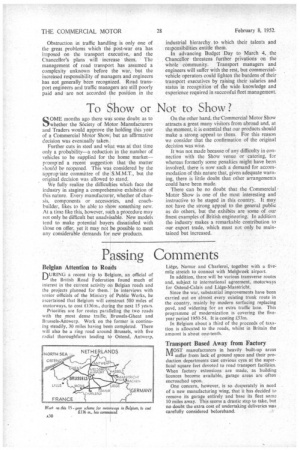Passing Comments
Page 32

Page 33

If you've noticed an error in this article please click here to report it so we can fix it.
Belgian. Attention to Roads
nURING a recent trip to Belgium, an official of " the British Road Federation found much of interest in the current activity on Belgian roads and the projects planned for them. In interviews with senior officials of the Ministry of Public Works, he ascertained that Belgium will construct 580 miles of motorways, to cost .£136m., during the next 15 years.
Priorities are for routes paralleling the two roads with the most dense traffic, Brussels-Ghent and Brussels-Antwerp. Work on the former is continuing steadily, 30 miles having been completed. There will also be a ring road around Brussels, with five radial thoroughfares leading to Ostend, Antwerp, Lidge, Namur and Charleroi, together with a five: mile stretch to connect with Meltbroek airport, In addition, there will be various transverse routes and, subject to international agreement, motorways for Ostend-Calais and Liége-Maastricht.
Since the war, substantial improvements have been carried out on almost every existing trunk route in the country, mainly by modern surfacing replacing pave, and widening for an extra traffic lane. This programme of modernization is covering the fiveyear period 1950-54. It is costing £53m.
In Belgium about a third of the proceeds of taxation is allocated to the roads, whilst in Britain the amount is about one-tenth.
Transport Based Away from Factory
MOST manufacturers in heavily. built-up areas ivi suffer from lack of ground space and their production departments cast envious eyes at the superficial square feet devoted to road transport facilities. When factory extensions are made, as building licences become available, garage areas are often encroached upon.
One concern, however, is so desperately in need of a new manufacturing wing, that it has decided to remove its garage entirely and base its fleet some 10 miles away. This seems a drastic step to take, but no doubt the extra cost of undertaking deliveries was carefully considered beforehand.
Grave Warning on Roads
A PROMINENT highway engineer, Mr. J. E.
Swindlehurst, M.1.Struct.E., borough engineer and surveyor of Hatnpstead, London, recently gave his presidential address to the British Section of the Society of French Civil Engineers.
After praising the efforts of road gvfety committees, Mr. Swindlehurst said that despite all the intensive efforts, the toll of the road went on, and there could be no relaxation in the search for further means for securing a substantial reduction. He believed that no marked improvement would result except by a bold policy, which would be in the nature of a major operation on the road system of the country. He added that the daywas fast approaching when many miles of main roads, including those near large centres of population, would have passed their useful life. If this were permitted, a form of creeping paralysis would affect all forms of road transport. It was plain that the policy of " make-do-andmend " must .soon be terminated. His views are heartily endorsed by the British Road, Federation, which is greatly concerned over the considerable increase in road accidents, and is constantly pressing for roads which will fit the traffic.
Latest in Tunnel Lighting
1VI0ST drivers in the Metropolitan area and many I" based elsewhere, know the Blackwall Tunnel, which was built in 1897. From the first it was lit electrically, the current being supplied by a small power station at the tunnel. Motor traffic demanded improvements and the lighting was extensively revised in 1930.
Horsed-vehicles were banned in 1939, but higher speed and larger vehicles have made further improvement essential, and in 1949 the London County Council, after consultation with the parties interested, decided to relight the tunnel completely at an estimated cost of £30,000. The first section of the new system, at the Poplar end, is in operation.
Tuntitl lighting presents peculiar difficulties. Drivers may plunge from sunlight to comparative gloom, but it is impracticable to illuminate the whole to daylight intensity, so the new lighting has beet arranged to taper off gradually from the entrance Maintenance used to be effected at night by a towe wagon, but the new lights are positioned at the sides Each has an 80-watt fluorescent tube with louvres tc obviate dazzle and glare, and each is connected by a fuse plug. The lamps give the effect of windows. thus serving as guide lines.




























































































